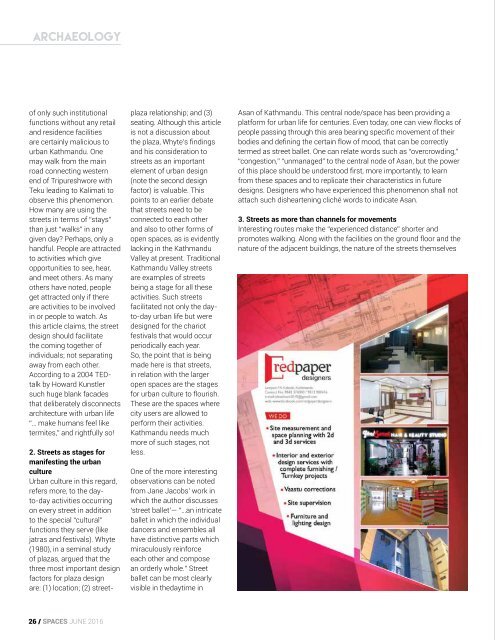SPACES June issue_3July16
Create successful ePaper yourself
Turn your PDF publications into a flip-book with our unique Google optimized e-Paper software.
archAeology<br />
of only such institutional<br />
functions without any retail<br />
and residence facilities<br />
are certainly malicious to<br />
urban Kathmandu. One<br />
may walk from the main<br />
road connecting western<br />
end of Tripureshwore with<br />
Teku leading to Kalimati to<br />
observe this phenomenon.<br />
How many are using the<br />
streets in terms of “stays”<br />
than just “walks” in any<br />
given day? Perhaps, only a<br />
handful. People are attracted<br />
to activities which give<br />
opportunities to see, hear,<br />
and meet others. As many<br />
others have noted, people<br />
get attracted only if there<br />
are activities to be involved<br />
in or people to watch. As<br />
this article claims, the street<br />
design should facilitate<br />
the coming together of<br />
individuals; not separating<br />
away from each other.<br />
According to a 2004 TEDtalk<br />
by Howard Kunstler<br />
such huge blank facades<br />
that deliberately disconnects<br />
architecture with urban life<br />
“… make humans feel like<br />
termites,” and rightfully so!<br />
2. Streets as stages for<br />
manifesting the urban<br />
culture<br />
Urban culture in this regard,<br />
refers more, to the dayto-day<br />
activities occurring<br />
on every street in addition<br />
to the special “cultural”<br />
functions they serve (like<br />
jatras and festivals). Whyte<br />
(1980), in a seminal study<br />
of plazas, argued that the<br />
three most important design<br />
factors for plaza design<br />
are: (1) location; (2) streetplaza<br />
relationship; and (3)<br />
seating. Although this article<br />
is not a discussion about<br />
the plaza, Whyte’s findings<br />
and his consideration to<br />
streets as an important<br />
element of urban design<br />
(note the second design<br />
factor) is valuable. This<br />
points to an earlier debate<br />
that streets need to be<br />
connected to each other<br />
and also to other forms of<br />
open spaces, as is evidently<br />
lacking in the Kathmandu<br />
Valley at present. Traditional<br />
Kathmandu Valley streets<br />
are examples of streets<br />
being a stage for all these<br />
activities. Such streets<br />
facilitated not only the dayto-day<br />
urban life but were<br />
designed for the chariot<br />
festivals that would occur<br />
periodically each year.<br />
So, the point that is being<br />
made here is that streets,<br />
in relation with the larger<br />
open spaces are the stages<br />
for urban culture to flourish.<br />
These are the spaces where<br />
city users are allowed to<br />
perform their activities.<br />
Kathmandu needs much<br />
more of such stages, not<br />
less.<br />
One of the more interesting<br />
observations can be noted<br />
from Jane Jacobs’ work in<br />
which the author discusses<br />
‘street ballet’— “…an intricate<br />
ballet in which the individual<br />
dancers and ensembles all<br />
have distinctive parts which<br />
miraculously reinforce<br />
each other and compose<br />
an orderly whole.” Street<br />
ballet can be most clearly<br />
visible in thedaytime in<br />
Asan of Kathmandu. This central node/space has been providing a<br />
platform for urban life for centuries. Even today, one can view flocks of<br />
people passing through this area bearing specific movement of their<br />
bodies and defining the certain flow of mood, that can be correctly<br />
termed as street ballet. One can relate words such as “overcrowding,”<br />
“congestion,” “unmanaged” to the central node of Asan, but the power<br />
of this place should be understood first, more importantly, to learn<br />
from these spaces and to replicate their characteristics in future<br />
designs. Designers who have experienced this phenomenon shall not<br />
attach such disheartening cliché words to indicate Asan.<br />
3. Streets as more than channels for movements<br />
Interesting routes make the “experienced distance” shorter and<br />
promotes walking. Along with the facilities on the ground floor and the<br />
nature of the adjacent buildings, the nature of the streets themselves<br />
26 / <strong>SPACES</strong> <strong>June</strong> 2016


















